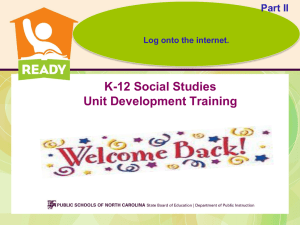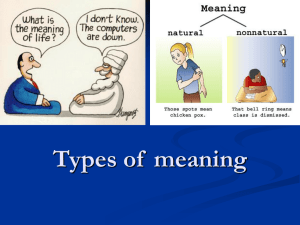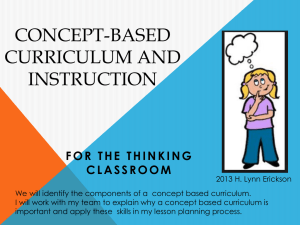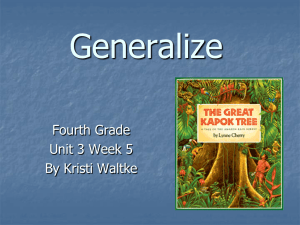For the Thinking Classroom Concept
advertisement
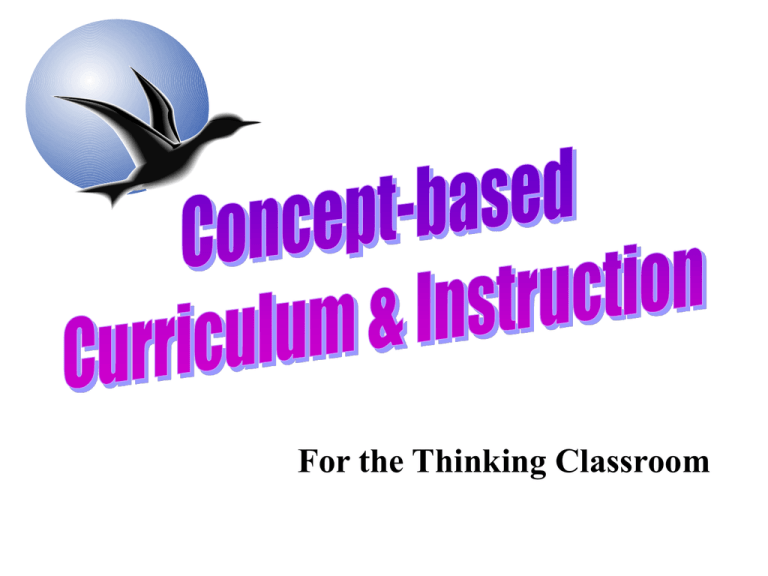
For the Thinking Classroom Let’s Think About… Two-dimensional vs. Three-dimensional Curriculum & Instruction The Structure of Knowledge The Power of a Conceptual Lens Unit Webs and Concepts Performances vs. Activities 2 Our Changing World 3 Living, Learning and Working Critical, Creative, and Conceptual Thinking 4 Living, Learning and Working Critical, Creative, and Conceptual Thinking 5 Two Dimensional Curriculum Model- Topic-based Processes & Skills Factual Content Concepts & Principles Three Dimensional Curriculum Model- Concept-based 6 Types of Knowledge Factual Conceptual Procedural 8 Think of— KNOW = Factual Knowledge which is locked in time, place or situation UNDERSTAND = Conceptual Understanding which transfers through time, across cultures, and across situations 9 The Structure of Knowledge 10 The Structure of Knowledge Cultures use available resources to meet their basic needs. The beliefs, values and heritage of a people help shape their cultural identity. Beliefs/values Identity Needs Resources Culture Mexican-American Culture F A C T S F A C T S F A C T S F F F F F A A A A A C C C C C T T T T T S S S S S 11 The Structure of Knowledge People migrate to meet a variety of needs. Migration may lead to new opportunities or greater freedom. • Migration • Opportunity • Needs • Freedom Westward Movement Early American settlers migrated west. Early American settlers looked for new opportunities. 12 High School Generalizations: Social Studies (examples) Government: 1. Forces of imperialism, nationalism, militarism, and geo-political alliances, taken to the extreme, can lead to international conflicts. History: 2. Key events in history can signal turning points that drastically alter the social, economic and political directions of a society. Economics: 3. Economic depression in one country can substantially affect the economies of other nations. Culture: 4. New technologies and scientific breakthroughs can improve the quality of life--but may also present ethical dilemmas. 13 The Structure of Knowledge An organism’s behavior patterns exhibit an evolutionary logic. Environmental factors influence an organism’s biology and behavior patterns. F A C T S F A C T S F A C T S F F F F F A A A A A C C C C C T T T T T S S S S S biology; evolution; mutation; environment; behavior patterns; adaptation; Texas Wildlife Preserves: Organisms and Adaptations 15 The Structure of Knowledge Velocity can be mathematically represented by the slope of a line. The slope of a graph at a particular point indicates the instantaneous rate of change. slope derivative line graph Measurement of distance and speed F A C T S F A C T S F A C T S F F F F F A A A A A C C C C C T T T T T S S S S S 17 Concept A concept is an organizing idea; a mental construct... • • • • • Timeless Universal Abstract Represented by 1 or 2 words Examples share common attributes 19 Examples of Subject Area Concepts -Science Order Organism Population System Change Evolution Cycle Interaction Energy/Matter Equilibrium - Social Studies Conflict/Cooperation Patterns Populations System Change/Continuity Culture Evolution Civilization Migration/Immigration Interdependence -Literary Concepts -Writers’ Craft Prejudice Perspective Conflict Cooperation Power Relationships Envy Emotions Oppression Influence Organization Word Choice Context Conventions Fluency Voice Presentation Symbolism Allegory Metaphor Protagonist Antagonist 20 21 Level 1 Verbs • affects • impacts • influence • is, are, have The student understands that_________________ __________________________________________ 22 The Structure of Knowledge The student understands that...__________________________________ ___________________. 2 1 Hurricane Katrina F A C T S F A C T S F A C T S 3 F F F F F A A A A A C C C C C T T T T T S S S S S 23 Sample Concepts Science Culture Natural disasters Ecosystems Habitats Bio-hazards Water quality Erosion Plant life Animal life Disaster responses Conflict Interdependence Social systems Endurance Economic impact Social impact Psychological impact Feelings of loss 24 The Structure of Knowledge The student understands that..._________________________________ ____________________. 2 1 U.S. Trade and Competition F A C T S F A C T S F A C T S 3 F F F F F A A A A A C C C C C T T T T T S S S S S 25 Examples of Subject Area Concepts - Economics – Social Studies Conflict/Cooperation Patterns Populations System Change/Continuity Culture Evolution Civilization Migration/Immigration Interdependence Markets Supply and Demand Cost Interdependence Beliefs/Values Goods/Services Conflict Cooperation Perceptions Patterns Power Systems 26 The Structure of Knowledge The student understands that...__________________________________ ___________________. Family and Community: F A C T S F A C T S F A C T S 3 2 1 ________ F F F F F A A A A A C C C C C T T T T T S S S S S 27 When we teach to the levels of concepts and generalizations we are teaching for deep understanding and the transfer of knowledge. 28 Scaffolding Thinking 29 Scaffolding Thinking to Complex Levels Social Studies Level 3 – Traditions help to unify a people. • So what—is the significance or effect…? Level 2 – Celebrations express traditions of a culture. – Why do cultures have celebrations? Level 1 – All cultures have celebrations. 30 Scaffolding Thinking to Complex Levels Science Level 3 – Animals that could not meet their needs in an environment would not survive. • So what if animals could not meet their needs in an environment? Level 2 – Animals meet their unique needs in different environments. • Why do animals live in different environments? Level 1 – Animals live in different environments. 31 Scaffolding Thinking to Complex Levels Level 3 Nations with a strong economic infrastructure wield greater political power in international relations. So what is the effect or significance of a strong economic infrastructure for a society? Level 2 Advances in technology lead to the development of new products and materials which can strengthen the economic infrastructure of a society. How (or Why) do advances in technology impact a society? Level 1 Advances in technology impact a society. 32 Scaffolding Understandings— Gothic Literature: Edgar Allan Poe Thematic “Big Ideas” (Enduring Understandings) Level 1 Guilt affects perception. Level 2 Guilt narrows and intensifies focus and shapes So what? perception. Level 3 Perception can cause people to make poor choices and decisions. The Writer’s Craft Level 1 Level 2 Consonance,assonance Consonance, assonance and alliteration enhance and alliteration create a flow to the language reading pleasure. through sound, rhyme, by Del Whitmire cadence and repetition. & Amy Pritzl How? Green Bay, WI. So what? Level 3 The use of literary devices creates moods and emphasizes words, connecting them to the 33 ideas they express. How? Scaffolding Thinking Level 1:_________________________________________________ ________________________________________________________ Why or How? Level 2: ________________________________________________ ________________________________________________________ So What—is the significance or effect? Level 3:________________________________________________ ________________________________________________________ 34 Uses critical content (topics and facts) as a tool to help students understand concepts and generalizations that transfer through time and across cultures. 35 36 Conceptual Lens? The American Media 37 Conceptual lens: Persuasive Force The American Media 38 Conceptual Lens:_________________ Topic:_______________ 39 Sample Conceptual Lenses Conflict Complexity Beliefs/Values Paradox Interdependence Interactions Freedom Transformations Identity Patterns Relationships Origins Change Revolution Perspective Reform Power Influence System Balance Structure/Function Innovation Design Genius Aesthetic Heroes Force Creativity 40 To develop the intellect and increase motivation for learning, curriculum and instruction must create a “synergy” between the lower (factual) and higher (conceptual) levels of thinking. Cartoons by David Ford davidford@cablespeed.com 41 42 © 2005 David Ford Cartoons 43 © 2005 David Ford Cartoons 44 It is the conceptual mind that… creates connections to prior experience and finds relevance; synergistically works with factual level knowledge to develop the intellect; creates deeper understanding at the factual and conceptual levels; recognizes the transferablity of knowledge. creates the motivation for learning 45 The Integration of Thinking 46 Curriculum Stew A Crisis is Simmering 47 Integration refers to the cognitive process of seeing patterns and connections at the conceptual level of thinking. 48 Coordinated, Multidisciplinary Topic Organizer: A Little Art A Little Math Use of Language Processes The Human Body The “Potpourri Unit” of facts & activities A Little Science A Little Literature 49 INTEGRATED, INTERDISCIPLINARY CURRICULUM… looks at a topically-based theme, problem, or issue through an integrating, “conceptual lens” such as Interdependence or System. 50 Integrated, Interdisciplinary Conceptual Lens: System Health Wellness Nutrition Eating Disorders Weight Management Substance Abuse Diseases Science Circulatory System Respiratory System Digestive System, etc. Function & structure Interdependence The Human Body Math Literature The Human Body (Science concepts) The Scarlet Ibis (J. Hurst) (limits of the human body) To the Top: Annapurna (Blum) (endurance, respiratory system) Physical Education Body Control Movement Coordination Musculatory System Fitness Endurance Calculations: heart rate, body mass, Statistics Measurements: height, weight Ratios Charts; graphs Art Draw a body: symmetry, line, shape Human forms - art realism, abstract, cubist 51 The goal of integration... ... is to facilitate integrated, higher level thinking. The conceptual lens pulls thinking to the integration level. 52 Industrialization and Paradox History • Native Americans Economics The Development Culture - attitudes and policies • Industrialization, the of the Industrial • Growth of cities toward Native advent of the modern United States - response of urban Americans corporation, and 1870-1900 leaders, such as by government material well-being architects and officials, the U.S. - ideas of business leaders philanthropists Army, missionaries, to limit competition and to the challenges and settlers maximize profits of rapid - Dawes Severalty Act • Farming, mining, and Geography urbanization of 1877 ranching • Industrialization and • Immigration after 1870 - commercial farming in the environment - changing patterns: the Northeast, South, - impact of rapid population, ethnicity, Great Plains, and West industrialization, Government religion, language, . Differences in terms of extractive mining • Growth of cities and place of origin, and crop production, farm techniques, and the changes in urban life motives labor, financing, and “gridiron” pattern of- increasing power of - response of Catholic urban political transportation urban growth on the and Jewish immigrants machines and how environment to religious they were viewed by discrimination immigrants and • New cultural movements middle class reformers 53 Integrated, Intradisciplinary Bond Energy • potential energy • bond strength • exothermic and endothermic bonds System/Interaction Modern Materials • liquid crystals • polymers • ceramics Compounds & Properties • amorphous solid • crystalline solid - moelcular, ionic, atomic • liquids - molecules with strong intermolecular forces • gases - molecules with weak (Conceptual Lens) Unit Theme Chemical Bonding Electronegativity • periodic table trend • ionic/covalent continuum Bond Types • covalent, ionic, metallic • polar covalent • orbital hybridization • sigma and pi bonds Molecular Shape Intermolecular Forces • VSEPR Theory • London dispersion • Valence-bond theory • dipole-dipole • polarity • hydrogen bonding intermolecular forces Figure 5.11. Chemistry Unit Source: Jean Lummis, Washington Township High School Washington Township School District, Sewell, New Jersey; used with permission Atomic Structures • valence electrons • formation of ions • electronegativity (Concepts italicized) 54 GENERALIZATION= Enduring Understanding Two or more concepts in a relationship... Concept Concept • CONCEPTUAL IDEAS THAT TRANSFER • DEVELOP “DEEP UNDERSTANDING’ 55 UNIVERSAL GENERALIZATIONS • • • • Broad and Abstract Universal in Application Generally Timeless Represented by different examples that support the generalization 56 GENERALIZATIONS PAST PAST PERFECT PRESENT PERFECT TENSE VERBS PROPER OR PERSONAL NOUNS 57 Sample Generalizations Science • Properties distinguish living and non-living things. • Genetic and environmental influences lead to diversity of populations. • Cells store energy in a variety of forms. • Environmental factors influence an organism’s biology and behavior patterns. 58 Mathematics Generalizations Examples Pre algebra: • Ordered pairs name a unique point of a grid. • Geometric figures encompass a measurable amount of space. Algebra: • Absolute value measures the distance from zero. • Rational numbers are a subset of the real number system. • Solving linear equations and inequalities involves the reversal of operations influencing the variable. Geometry: • Geometric figures can be replicated or distorted through transformations. Algebra 3/4 • A root is the inverse of a power. • Triangular and circular representations define trigonometric functions. 59 Types of Guiding Questions Provocative/Debatable – (or “essential questions”) “Can a nation have too much wealth?” “Should a more powerful nation dominate weaker nations?” “Is war ever justifiable?” Conceptual – “Why do nations desire to explore new lands?” Factual - “In what ways did the early American explorers disrupt Native American cultures?” 61 Student Performances: Reflect the most important Understand (Generalizations), Know (Factual Knowledge), and able to Do (Skills) of the unit Student Performances are the assessment evidence of mastery. Student Performances are not simple “activities.” 62 Working on Performance Statements Key Understanding (Generalization): Watershed events mark turning points in history. TEKS: “Analyze Lincoln’s ideas about liberty, equality, union, and government as contained in his first and second inaugural address and the Gettysburg Address.” Student Performance or Activity? Recite from memory key passages from the Gettysburg Address. 63 Working on Performance Statements Key Understanding (Generalization): Watershed events mark turning points in history. TEKS: “Analyze Lincoln’s ideas about liberty, equality, union, and government as contained in his first and second inaugural address and the Gettysburg Address.” Student Performance or Activity? Recite from memory key passages from the Gettysburg Address. Tell why Lincoln’s Gettysburg Address is considered a “watershed event” in American History 64 Working on Performance Statements Key Understanding (Generalization): Political documents can set forth social ideals such as justice, equality, or freedom, but the path to ideals is impeded by conflicting notions. TEKS “Identify the influence of ideas from historic documents including the Magna Carta, the English Bill of Rights, the Mayflower Compact, the Declaration of Independence, the Federalist Papers, and selected anit-federalist writing on the U.S. system of government.” Student Performance or Activity? Create an outline highlighting social ideas such as justice, equality, or freedom for the Magna Carta, the English Bill of Rights, the Mayflower Compact, the Declaration of Independence, the Federalist Papers, and selected AntiFederalist writing on the U.S. Constitution. Select one of these social ideas and describe how conflicting notions have impeded the progress to these ideals. [cite specific examples from history or current events to support your position.] 65 Working on Performance Statements Key Understanding (Generalization): As a society becomes more complex, the role of government increases in the daily life of its citizens. TEKS “Explain the impact of significant international events such as WWI and WWII on changes in the role of government.” “Predict the effects of selected contemporary legislation on the roles of government.” Student Performance or Activity? Create a 3-column chart. In the first column list significant international events such as WWI, WWII and Global Terrorism. In the second column show some of the resulting U.S. legislation, or governmental policies, enacted in response to these events. In the third column detail the impact of the legislation on the daily life of citizens. In a paragraph below the chart, answer this question: “How does the increasing complexity (social, economic, political) 66 of a society lead to the expansion of government?” Science: Working with Student Performances Key Understanding (Generalization): Organisms maintain a constant internal environment called homeostasis in order to ensure survival. TEKS “Describe how organisms maintain stable internal conditions while living in changing external environments.” Student Performance or Activity? Create a symbol or design to represent the idea of “homeostasis.” 67 Science: Working with Student Performances Key Understanding (Generalization): Organisms maintain a constant internal environment called homeostasis in order to ensure survival. TEKS “Describe how organisms maintain stable internal conditions while living in changing external environments.” Student Performance: Create a symbol or design to represent the idea of “homeostasis.” Write a summary paragraph under your symbol or design telling how it represents the idea of homeostasis; then tell why homeostasis is important for organisms that live in changing external environments. 68 Mathematics-Grade 8 • Key Understanding (Generalization): The arc of an angle, measured in degrees, indicates whether the angle is acute, obtuse, or right. • TEKS Use angle measurements to classify angles as acute, obtuse, or right. • Student Performance or Activity? Classify each of the following angles as 1) acute, 2) obtuse, or 3) right: ____ 90 degrees ____180 degrees ____ 120 degrees ____ 30 degrees ____ 60 degrees ____ 45 degrees Write an answer to this question: What is the relationship between the arc of an angle and its classification? 69 English/Language Arts High School • Key Understanding (Generalization): Authors use connotative language to create strong images, or to move the reader to figurative rather than literal interpretations. • TEKS Discriminate between connotative and denotative meanings and interpret the connotative power of words. • Student Performance or Activity? In this excerpt from Shakespeare’s “Taming of the Shrew,” highlight denotative language in blue, and connotative language in red.” 70 English/Language Arts High School • Key Understanding (Generalization): Authors use connotative language to create strong images, or to move the reader to figurative rather than literal interpretations. • TEKS Discriminate between connotative and denotative meanings and interpret the connotative power of words. • Student Performance or Activity? In this excerpt from Shakespeare’s “Taming of the Shrew,” highlight denotative language in blue, and connotative language in red.” What do we have to add to turn this into a Performance? 71 Working on Performance Statements Key Understanding (Generalization): “People celebrate national holidays to recognize the contributions of famous people and special events.” “People may use symbols to recognize certain holidays.” TEKS: Recognize the importance of national holidays. Identify symbols that are associated with certain holidays. Student Performance or Activity? Choose two of the following holidays and tell why people celebrate that day. Martin Luther King Day July 4th Veterans’ Day Cinco de Mayo… Match each symbol to its related holiday: United States Flag Peace or Freedom Symbol… 72 Mathematics • Key Understanding (Generalization): Standard units of measure allow accurate, numerical comparisons of objects. Non-standard units of measure provide a general comparison of objects. • TEKS: Measure objects using standard units of measure. Measure objects using non-standard, everyday items. • Student Performance or Activity? Use a 12 inch ruler to compare the length of a book, your foot, and the side of your desk. Record your results on the chart. Choose a non-standard item (pencil, your hand, an opened paper clip…) and measure the same objects. Record your results. 73 Mathematics • Key Understanding (Generalization): Standard units of measure allow accurate, numerical comparisons of objects. Non-standard units of measure provide a general comparison of objects. • TEKS: Measure objects using standard units of measure. Measure objects using non-standard, everyday items. • Student Performance or Activity? Use a 12 inch ruler to compare the length of a book, your foot, and the side of your desk. Record your results on the chart. Choose a non-standard item (pencil, your hand, an opened paper clip…) and measure the same objects. Record your results. In two paragraphs compare the lengths of the book, your foot, and the side of your desk as accurately as possible for both your standards ruler measurements, and your non-standard item measurements. Answer the question: “Why do home builders use standard units of measure?” Differentiation: Have advanced students compare their measurements (standard and non-standard) with another student, chart their differences, and determine how they could “standardize” their non-standards measurements. (hint: use a ruler74 to measure the exact length of a non-standard item) _______________:Working with Student Performances Subject/Grade Level • Key Understanding (Generalization): • TEK: • Student Performance [expectation(s)]: Lesson Plan: 75
